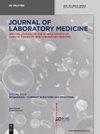Research on the stability changes in expert consensus of the ACTH detection preprocessing scheme
IF 1.8
4区 医学
Q4 MEDICAL LABORATORY TECHNOLOGY
引用次数: 0
Abstract
Objectives Adrenocorticotropic hormone (ACTH) is extremely unstable and can easily degrade at room temperature. The experts agreed that the samples should be transported in an ice bath. If it cannot be detected immediately, the plasma should be separated and frozen, which is difficult to carry out in routine practice. This study was performed to explore the preanalytical factors that influence the stability of adrenocorticotrophic hormone (ACTH) measurements. Methods ACTH levels in 21 EDTA whole-blood samples were measured immediately after 0 h and then divided into three equal groups according to the corresponding values (low, L; median, M; and high, H). Next, three sample processing methods (including seven subtypes) were used: whole blood was uncentrifuged (named the A method), stored at 4 °C or 22 °C, centrifuged but not subjected to plasma removal (the B method), stored at 4 °C or 22 °C, and centrifuged with the plasma removed and stored (the C method) at 4 °C, 22 °C, and −20 °C. Each subtype contained three samples, namely, L, M, and H; these samples were retested using a Siemens XP2000 at different times. The change bias was calculated at 0 h. Results Compared to that at 0 h, there was no significant change in ACTH up to 24 h when the sample was stored at 4 °C or 22 °C with the B method (p>0.05), while it significantly changed (up or down >10 %) at 4 °C/24 h (bias is expressed as the mean±SEM; 13.37±21 %, p<0.05) and 22 °C/12 h (9.13±7.68 %, p<0.05) with the A method; and 4 °C/24 h (8.93±5.54 %, p<0.05), 22 °C/12 h (9.5±4.47 %, p<0.05) and −20 °C/3 h (12.03±4.8 %, p<0.05) with the C method. Conclusions After ACTH samples were centrifuged, the presence of plasma without removal did not affect the detection value, and the sample was stored at 4 °C for up to 24 h. There was a significant difference in the detection of ATCH when the sample was stored at −20 °C and thawed again (p<0.05).ACTH检测预处理方案专家共识稳定性变化研究
目标 促肾上腺皮质激素(ACTH)极不稳定,在室温下很容易降解。专家们一致认为,样本应在冰浴中运输。如果不能立即检测到,则应将血浆分离并冷冻,而这在日常工作中很难进行。本研究旨在探讨影响肾上腺皮质激素(ACTH)测定结果稳定性的分析前因素。方法 0 小时后立即测量 21 份 EDTA 全血样本中的促肾上腺皮质激素(ACTH)水平,然后根据相应值将样本分为三个等量组(低,L;中值,M;高,H)。然后,采用三种样本处理方法(包括七种亚型):全血不离心(命名为 A 法),在 4 °C 或 22 °C 下保存;离心但不去除血浆(B 法),在 4 °C 或 22 °C 下保存;离心并去除血浆,在 4 °C 、22 °C 和 -20 °C 下保存(C 法)。每个亚型包含三个样本,即 L、M 和 H;使用西门子 XP2000 在不同时间对这些样本进行复测。结果 与 0 h 时相比,用 B 方法将样本保存在 4 °C 或 22 °C 时,ACTH 在 24 h 前没有显著变化(p>0.05),而在 4 °C/24 h 时,ACTH 有显著变化(上升或下降 >10%)(偏差用均数±标准平均值表示;13.用 A 法,4 °C/24 h (8.93±5.54 %,p<0.05)、22 °C/12 h (9.5±4.47 %,p<0.05) 和 -20 °C/3 h (12.03±4.8 %,p<0.05);用 C 法,4 °C/24 h (8.93±5.54 %,p<0.05)、22 °C/12 h (9.5±4.47 %,p<0.05) 和 -20 °C/3 h (12.03±4.8 %,p<0.05)。结论 ACTH 样品离心后,未去除的血浆的存在不影响检测值,样品在 4 °C 下可保存 24 小时。
本文章由计算机程序翻译,如有差异,请以英文原文为准。
求助全文
约1分钟内获得全文
求助全文
来源期刊

Journal of Laboratory Medicine
Mathematics-Discrete Mathematics and Combinatorics
CiteScore
2.50
自引率
0.00%
发文量
39
审稿时长
10 weeks
期刊介绍:
The Journal of Laboratory Medicine (JLM) is a bi-monthly published journal that reports on the latest developments in laboratory medicine. Particular focus is placed on the diagnostic aspects of the clinical laboratory, although technical, regulatory, and educational topics are equally covered. The Journal specializes in the publication of high-standard, competent and timely review articles on clinical, methodological and pathogenic aspects of modern laboratory diagnostics. These reviews are critically reviewed by expert reviewers and JLM’s Associate Editors who are specialists in the various subdisciplines of laboratory medicine. In addition, JLM publishes original research articles, case reports, point/counterpoint articles and letters to the editor, all of which are peer reviewed by at least two experts in the field.
 求助内容:
求助内容: 应助结果提醒方式:
应助结果提醒方式:


